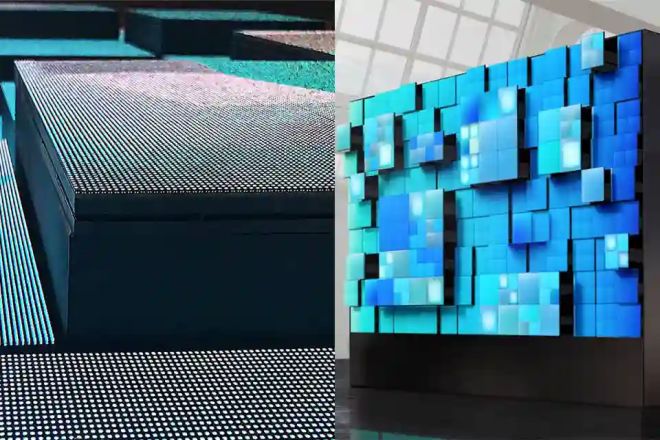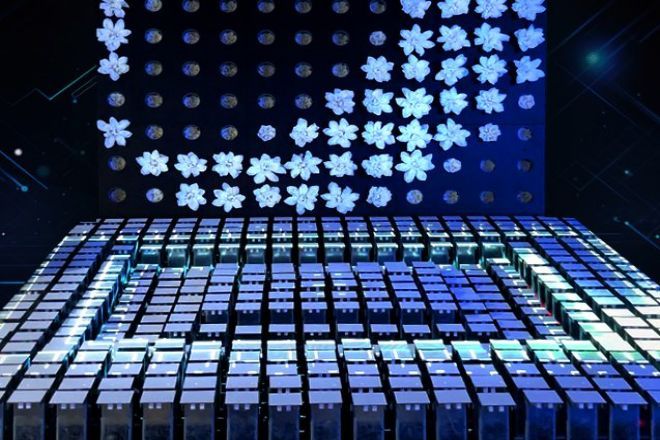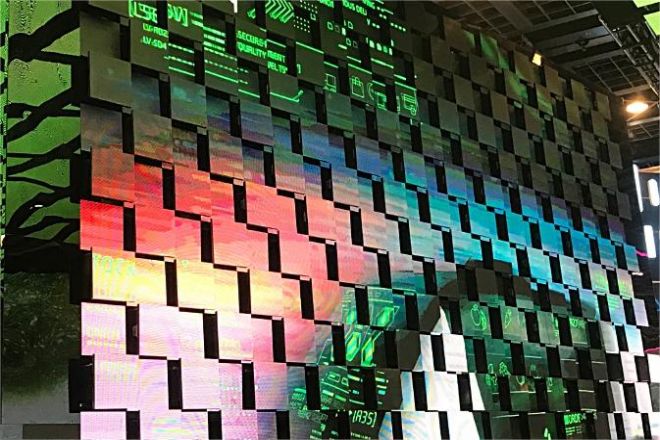Introducción
Con el avance creciente de la ciencia y la tecnología, el campo de la pantallas de visualización LED está marcando el comienzo de la innovación tecnológica. Como producto innovador que combina la tecnología de visualización 3D y la tecnología de energía cinética mecánica, la pantalla LED de energía cinética 3D no solo proporciona una experiencia visual enriquecida, sino que también brinda una experiencia interactiva más inmersiva a la audiencia a través de efectos dinámicos mecanizados.
1. Descripción general de la pantalla LED de energía cinética 3D

La pantalla LED de energía cinética 3D es una pantalla LED que combina la tecnología de energía cinética mecánica y la tecnología de visualización 3D. No solo ofrece una visualización de imágenes y videos de alta calidad, sino que también brinda una experiencia visual inmersiva a la audiencia a través de efectos dinámicos mecanizados.
Este tipo de pantalla de visualización suele estar equipada con sistemas de energía cinética mecánica, como servomotores y dispositivos de transmisión, para que el contenido de la pantalla se pueda presentar de forma dinámica y móvil.
En comparación con las pantallas LED tradicionales, las pantallas LED de energía cinética 3D tienen las siguientes diferencias y ventajas significativas:
Efecto de visualización 3D: Las pantallas LED tradicionales solo pueden presentar imágenes y vídeos planos, mientras que las pantallas LED cinéticas 3D pueden mostrar imágenes tridimensionales, haciendo que el público se sienta como si realmente estuviera allí.
Efecto dinámico: Impulsada por el sistema de energía cinética mecánica, la pantalla LED de energía cinética 3D puede lograr contenido de visualización dinámico y móvil, como cambios dinámicos en texto, imágenes y videos, lo que aumenta la diversión y el atractivo del contenido mostrado.
Experiencia interactiva: Combinadas con sensores y sistemas de control, las pantallas LED de energía cinética 3D pueden interactuar con la audiencia, como controlar cambios en el contenido de la pantalla a través de gestos, tacto, etc., brindando una experiencia interactiva más rica a la audiencia.
2. Principio de funcionamiento de la pantalla LED de energía cinética 3D
Imaginemos que una pantalla LED normal es como un marco de fotos estático, que solo puede mostrar una imagen plana. Sin embargo, la pantalla LED de energía cinética 3D es diferente. Es como un escenario en movimiento. Las imágenes que contiene no solo se pueden mostrar, sino que también se pueden mover.
¿Y cómo lo hace? La respuesta es la introducción de sistemas dinámicos mecánicos con movilidad. Este sistema es como las “manos y los pies” de la pantalla, que le permiten “moverse”.
¿Cómo están compuestas estas “manos y pies”? Hay tres partes clave:
Servomotor: Es como un potente “motor” que puede proporcionar una salida de potencia precisa para hacer que el contenido en la pantalla se mueva de la manera que queremos.
Dispositivo de transmisión: Es como el “brazo” que conecta el “motor” y la pantalla de visualización y es responsable de transmitir la potencia del servomotor al módulo LED en la pantalla de visualización.
Módulo de control de movimiento: Es como el “cerebro” de la pantalla. Puede recibir nuestras instrucciones preestablecidas o señales externas y luego indicarle al servomotor cómo moverse, por ejemplo, rotación, traslación o elevación.
Por lo tanto, cuando reproducimos un video, la pantalla LED de energía cinética 3D puede hacer que la imagen se mueva a través del sistema dinámico mecánico de acuerdo con el contenido del video, brindando una experiencia 3D más realista y vívida a la audiencia.
3. Análisis de las tecnologías clave de la pantalla LED de energía cinética 3D

1) Tecnología de pantalla LED
La tecnología de pantalla LED es la base de la pantalla LED de energía cinética 3D. Sus tecnologías clave incluyen:
- Aplicación de chips LED de alto brillo y alta definición:
El uso de chips LED de alta definición y alto brillo puede garantizar que la pantalla mantenga un efecto de visualización nítido en exteriores o en entornos con mucha luz. Al mismo tiempo, los chips LED de alta definición pueden presentar imágenes más delicadas y mejorar la experiencia de visualización del público.
- Diseño optimizado de matriz de píxeles LED:
Mediante un diseño razonable y optimizado de la matriz de píxeles LED, se puede lograr una mayor densidad de píxeles y un mejor efecto de visualización. Al mismo tiempo, el diseño optimizado también puede mejorar la confiabilidad y la estabilidad de la pantalla y reducir la tasa de fallas.
- Tecnología de gestión y calibración del color:
La tecnología de calibración y gestión del color es la clave para garantizar colores precisos y vivos en las pantallas LED. Mediante instrumentos y software de calibración del color profesionales, se pueden ajustar con precisión la temperatura del color, el brillo, la saturación y otros parámetros de la pantalla para lograr el mejor efecto de color.
2) Tecnología de visualización 3D
La tecnología de visualización 3D es el núcleo de la pantalla LED de energía cinética 3D. Sus tecnologías clave incluyen:
- Tecnología de producción y conversión de contenidos 3D:
Para presentar efectos 3D realistas en una pantalla LED cinética 3D, se requiere tecnología especializada de producción y conversión de contenido 3D. Estas tecnologías pueden convertir contenido 2D en contenido 3D o producir contenido 3D especializado para adaptarse al efecto de visualización 3D.
- Mejora y ajuste de efectos visuales estereoscópicos:
Al ajustar el brillo, el contraste, el ángulo de visión y otros parámetros de la pantalla, se pueden mejorar aún más los efectos visuales estereoscópicos. Al mismo tiempo, también se pueden utilizar medios técnicos como puntos de vista múltiples y niveles múltiples para permitir que los espectadores vean efectos 3D claros en diferentes ubicaciones.
- Tecnología de adaptación dinámica de la perspectiva del espectador:
Dado que los espectadores pueden estar en diferentes posiciones y ángulos al mirar la pantalla, se necesita una tecnología de adaptación dinámica de la perspectiva del espectador. Esta tecnología puede ajustar automáticamente el contenido de la pantalla y el ángulo de la misma según los cambios en la perspectiva del espectador, lo que garantiza que el espectador siempre pueda ver el mejor efecto 3D.
3) Tecnología de energía cinética mecánica
La tecnología de energía cinética mecánica es la clave para lograr efectos dinámicos en las pantallas LED de energía cinética 3D. Sus tecnologías clave incluyen:
- Diseño de sistema de control de movimiento de alta precisión:
El sistema de control de movimiento de alta precisión es la base para garantizar el movimiento preciso del módulo LED en la pantalla. El sistema requiere un alto grado de precisión y estabilidad para garantizar que los efectos de movimiento de la pantalla cumplan con los requisitos preestablecidos.
- Adaptación y optimización de servomotores y dispositivos de transmisión:
Los servomotores y los dispositivos de transmisión son los componentes principales del sistema de energía cinética mecánica. Para garantizar el mejor efecto de movimiento de la pantalla, el servomotor y el dispositivo de transmisión deben coincidir y optimizarse con precisión. Esto incluye la selección del modelo de motor adecuado, la optimización de la estructura y los parámetros de la transmisión, etc.
- Tecnología de control síncrono para efectos dinámicos y pantalla LED:
Para garantizar la coordinación entre el sistema de energía cinética mecánica y el sistema de visualización LED, es necesario adoptar una tecnología de control sincrónico para efectos dinámicos y pantallas LED. Esta tecnología garantiza que los módulos LED de la pantalla permanezcan sincronizados con el contenido de vídeo reproducido cuando se mueven, presentando así un efecto 3D más realista y fluido.
4. Campos de aplicación de la pantalla LED de energía cinética 3D
1) Publicidad y exhibición comercial
- Promoción de marca y promoción de productos:
El alto brillo y la alta definición de la pantalla LED de energía cinética 3D la convierten en una excelente opción para la promoción de marcas y productos. A través de métodos de visualización dinámicos y tridimensionales, puede atraer más atención de los consumidores y aumentar el conocimiento de la marca y las ventas de productos.
- Experiencia interactiva llamativa:
Su diseño móvil puede agregar más diversión e interactividad a los anuncios, atraer a los consumidores para que se detengan, miren y participen en las interacciones y mejorar el efecto de conversión de los anuncios.
- Contenido publicitario actualizado en tiempo real:
Gracias a sus características digitales, la pantalla LED de energía cinética 3D puede actualizar rápidamente el contenido publicitario, mantener la frescura y relevancia de la información y satisfacer las necesidades de los anunciantes de seguimiento y ajuste en tiempo real de los efectos publicitarios.
2) Entretenimiento y representación escénica
- Actuaciones en directo como conciertos:
En presentaciones en vivo, como conciertos y presentaciones, la pantalla LED cinética 3D se puede utilizar como una gran pantalla de fondo para presentar efectos visuales más impactantes y realistas a la audiencia. Al reproducir imágenes dinámicas que coincidan con el contenido de la presentación, puede crear una atmósfera más fuerte y mejorar la experiencia visual de la audiencia.
- Combinación de aplicaciones de realidad virtual y realidad aumentada:
Las pantallas LED cinéticas 3D se pueden combinar con tecnologías de realidad virtual y realidad aumentada para ofrecer a los espectadores una experiencia visual más inmersiva. Por ejemplo, en un concierto, el público puede usar gafas de realidad virtual y utilizar la pantalla LED de energía cinética 3D para interactuar de cerca con los artistas como si estuvieran en el lugar de los hechos.
- La experiencia interactiva entre el público y los intérpretes:
Su diseño interactivo y móvil permite acortar la distancia entre el público y los intérpretes, lo que permite que el público participe más profundamente en la actuación. Por ejemplo, en un concierto, el público puede interactuar con los intérpretes en tiempo real enviando comentarios o participando en votaciones a través de teléfonos móviles u otros dispositivos.
3) Exposiciones y muestras museísticas
- Exposición tridimensional de reliquias históricas y obras de arte:
En exposiciones y museos, las pantallas LED cinéticas 3D se pueden utilizar para mostrar imágenes tridimensionales de reliquias históricas y obras de arte. A través de la tecnología de captura y renderización de imágenes de alta precisión, se puede presentar el efecto tridimensional de las reliquias culturales y las obras de arte, lo que permite a los espectadores comprender de forma más intuitiva detalles como su forma, estructura y textura.
- Combinación de experiencia interactiva y funciones educativas:
Además de las funciones de visualización, las pantallas LED de energía cinética 3D también se pueden combinar con experiencias interactivas y funciones educativas. Por ejemplo, en un museo, los visitantes pueden interactuar con las exposiciones y obtener conocimientos e información relevantes tocando la pantalla o usando gafas de realidad virtual. Esta experiencia interactiva no solo aumenta la participación y el interés del público, sino que también mejora el aprendizaje.
- Integración de sistemas de visualización multimedia y navegación:
Las pantallas LED cinéticas 3D se pueden integrar con sistemas de navegación y visualización multimedia para brindar al público una experiencia de visita más completa y conveniente.
Al mostrar contenido multimedia, como videos, audio e imágenes relacionados con las exhibiciones y brindar servicios de navegación inteligentes, el público puede comprender mejor el contexto histórico y las connotaciones culturales de las exhibiciones y obtener una comprensión más profunda del tema y el contenido de la exhibición.
5. Desafíos y desarrollo futuro de las pantallas LED de energía cinética 3D

1). Desafíos técnicos
- El equilibrio entre el efecto de visualización y el consumo de energía:
Si bien las pantallas LED de energía cinética 3D buscan un alto brillo, una alta definición y efectos dinámicos, también enfrentan el problema del aumento del consumo de energía. Cómo reducir el consumo de energía y al mismo tiempo garantizar los efectos de visualización es una cuestión importante que debe resolverse en la investigación y el desarrollo de tecnología.
- Estabilidad y fiabilidad de los sistemas mecánicos:
Como componente principal de la pantalla LED de energía cinética 3D, la estabilidad y la confiabilidad del sistema dinámico mecánico afectan directamente la vida útil y el efecto de la pantalla. Cómo garantizar que los sistemas mecánicos puedan funcionar de manera estable en diversos entornos es otro desafío importante en la investigación y el desarrollo de tecnología.
- Altos costos y problemas de mantenimiento:
En la actualidad, el costo de las pantallas LED de energía cinética 3D es relativamente alto, lo que limita su popularidad y aplicación en el mercado. Al mismo tiempo, debido a su compleja estructura y tecnología, el mantenimiento también es difícil. En el futuro, la reducción de costos y la simplificación de los procesos de mantenimiento serán direcciones importantes para la investigación y el desarrollo de tecnología.
2). Desafíos del mercado
- Aceptación del consumidor y cultivo del mercado:
En el caso de las pantallas LED de energía cinética 3D, que están surgiendo, aún es necesario mejorar la concienciación y la aceptación de los consumidores. Es necesario promover y popularizar el mercado a través de diversos canales para aumentar la concienciación y el interés de los consumidores en los productos.
- Panorama competitivo y construcción de marca:
A medida que el mercado continúa desarrollándose, la competencia en el campo de las pantallas LED de energía cinética 3D se volverá cada vez más feroz. Las empresas necesitan fortalecer la construcción de la marca y mejorar la calidad del producto y los niveles de servicio para diferenciarse de la competencia.
2) Tendencias futuras
- Pantalla LED de energía cinética 3D flexible y plegable:
Con el desarrollo continuo de la tecnología de pantallas flexibles, se espera que las pantallas LED de energía cinética 3D logren diseños flexibles y flexibles en el futuro. Esto aportará mayor flexibilidad y adaptabilidad al producto para satisfacer las necesidades de uso en diferentes escenarios.
- El desarrollo de la inteligencia y la creación de redes:
Con el desarrollo continuo de tecnologías como Internet de las cosas, big data e inteligencia artificial, las pantallas LED de energía cinética 3D lograrán funciones más inteligentes y en red en el futuro. A través de la conexión e interacción con otros dispositivos inteligentes, se logran métodos de visualización y control más convenientes e inteligentes.
- Integración de experiencias interactivas multisensoriales:
Además de la experiencia visual, las futuras pantallas LED de energía cinética en 3D también integrarán experiencias interactivas multisensoriales. Por ejemplo, la combinación de sonido, tacto y otros elementos sensoriales puede brindar una experiencia interactiva más completa e inmersiva a la audiencia.
- Soluciones personalizadas y a medida:
Con la segmentación continua de la demanda del mercado y el fortalecimiento de la tendencia de personalización, las pantallas LED de energía cinética 3D prestarán más atención a las soluciones personalizadas en el futuro. Las empresas deben proporcionar productos y servicios personalizados en función de las necesidades y escenarios de los diferentes clientes para satisfacer las diversas necesidades del mercado.
Conclusión
La pantalla LED de energía cinética 3D ha traído cambios revolucionarios a los campos de la publicidad, el entretenimiento, las exhibiciones y otros campos con su energía cinética mecánica única y su efecto de visualización 3D.
Aunque todavía enfrenta algunos desafíos técnicos y de mercado, con el avance continuo de la tecnología y la madurez gradual del mercado, se espera que las pantallas LED de energía cinética 3D muestren perspectivas de aplicación más amplias en el futuro.
Finalmente, si quieres conocer más información sobre las pantallas LED, Por favor póngase en contacto con nosotros.
